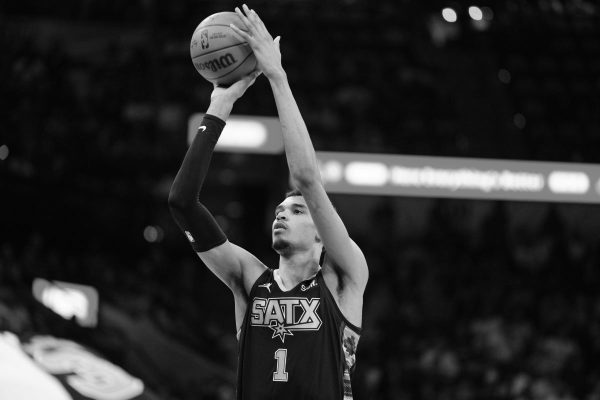As More Players Kneel, NFL Protest Loses Sight of Original Purpose
Before the start of the San Francisco 49ers’ first preseason game of 2016 against the Houston Texans, second-string quarterback Colin Kaepernick decided to stay on the bench. Most people did not notice, as he was far enough down in the depth-chart that he did not even suit up for the game. However, it was the start of his now-infamous national anthem protest that has the whole league kneeling, and somehow, the more people that partake, the further away the protest gets from its original goal.
It was not until his third preseason game last year, on Aug. 26, that people began to notice that he was sitting for the anthem. When asked about it after the game, he said he sat because of police brutality and the oppression of people of color. His actions were faced with outrage — many claiming that he was disrespecting the U.S. flag, so two days later he expanded on his point.
“I’m going to continue to stand with the people that are being oppressed,” Kaepernick said in an interview with USA Today. “To me, this is something that has to change. When there’s significant change and I feel like that flag represents what it’s supposed to represent, this country is representing people the way that it’s supposed to, I’ll stand.”
At this point in Kaepernick’s career, he had little to lose. After many key members of the 49ers’ 2013 NFC Championship Team retired, Kaepernick, whose electric play was credited to his team making the Super Bowl, started to decline. In fact, going into the season, he knew he was no longer the starter, and, considering the size of his massive $126 million contract through the year 2020, he also knew he would likely be cut soon.
However, he continued to use his platform as a one-time elite NFL quarterback to send his message, and on Sep. 1, 2016, Kaepernick, along with teammate Eric Reid, decided to kneel during the national anthem. Reid, a Pro Bowl strong safety, had harbored fear and anger over recent incidents of police brutality and wanted to do something to voice his opinions. After a conversation between the two of them and retired Green Beret and NFL player Nate Boyer, they decided that kneeling was the best, and most respectful, way to get their message across.
Just like that, without starting a game, Colin Kaepernick became the most polarizing athlete in the U.S. Some claimed he was disrespecting the flag, some said he was trying to regain popularity to prove his place on the team, and some agreed with his stance, even joining in with his protest. Seattle Seahawks player Jeremy Lane, then-Denver Broncos receiver Brandon Marshall, and FIFA World Cup Champion soccer player Megan Rapinoe followed suit within just a week of Kaepernick’s first kneel.
Now, over a year removed from the start of Kaepernick’s protest, the protest has blown up more than the quarterback ever could have imagined. President Donald Trump chimed in last Saturday, condemning players who kneel and claiming that the protest is not about race, but about disrespecting the flag.
“If a player wants the privilege of making millions of dollars in the NFL, or other leagues, he or she should not be allowed to disrespect … our Great American Flag (or Country) and should stand for the National Anthem,” Trump tweeted. “If not, YOU’RE FIRED. Find something else to do!”
His comments prompted the response of almost the entire league, as many NFL owners decided to release statements of support or even lock arms and kneel with their players, as was the case with outspoken Dallas Cowboys owner Jerry Jones. The Cowboys, dubbed “America’s Team” because of their huge fan base and influence, all knelt in a line Monday night.
The protests have driven the NFL fan-base into a frenzy, as some respect players firing back at our president, while others are appalled by what they believe to be blatant disrespect of the flag and the military. This divide has been so stark that it is even evident on the field.
The Pittsburgh Steelers decided to protest by staying in the tunnel during the national anthem. While this move made a statement, it was highlighted by Alejandro Villanueva, a four-year veteran, who stood on the corner of the field with his hand on his heart during the anthem. As an officer in the U.S. Army and a member of the Army Rangers, he did not want to disrespect himself and the people he served with, even if it isolated him from his team.
Kaepernick’s original goal — to provide a voice for the oppressed — has been lost in all of the debate over who is disrespecting the flag and the military, as well as what role athletes have in politics. If anything, the voice that Kaepernick was trying to stand up for has been completely removed from the conversation.
Many NFL owners actually endorsed Trump during the election, including eight who publicly donated to his campaign. Woody Johnson, the owner of the New York Jets, played such a large role in the campaign that he is now the United States Ambassador to the United Kingdom. So as athletes such as Tom Brady, who tried to shy away from his public relationship with Trump during the election, locked arms with his teammates, the motive of Sunday’s protests became unclear. However, whether it be to show Trump that the NFL doesn’t take orders from anyone, or just to increase long-declining ratings from concerns of the long-term affects of head trauma, it has nothing to do with Colin Kaepernick.
Maybe if some owners did believe in what he knelt for, they would actually sign him.



